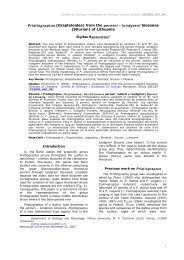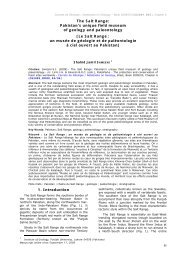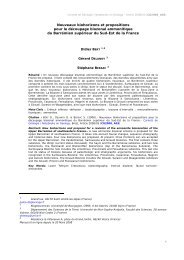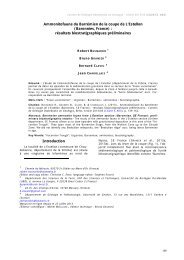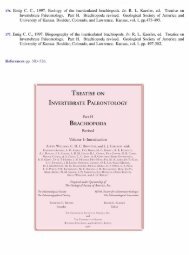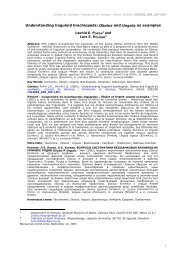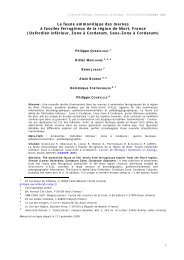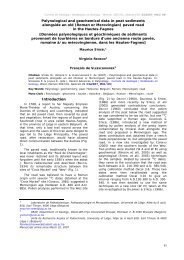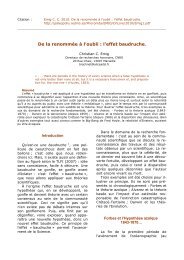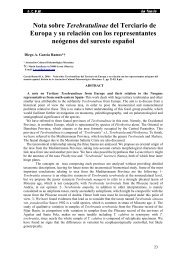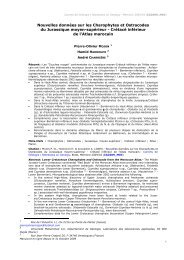View - Paleopolis - RedIRIS
View - Paleopolis - RedIRIS
View - Paleopolis - RedIRIS
Create successful ePaper yourself
Turn your PDF publications into a flip-book with our unique Google optimized e-Paper software.
134 PALAEONTOLOGY, VOLUME 54Oral side50 µmApertureLipNeck BodyOral sideAperturePeri-oral ridgeRadialcrestEquatorial ribAboral sideSymmetry axisFoot ArmExpansions50 µmAboralsideFlankPeri-apicalsurfaceSymmetry axisEquatorialcollaretteMeridian ribAboral collaretteTEXT-FIG. 1. Terminology used in descriptions of gilianelleswith discoidal body (genus Gilianella; modified from Odin2007).TEXT-FIG. 2. Terminology used in description of gilianelleswith a cupula-like body (genus Pocillella).collected from a section in Navarra, northern Spain (Odin2008b). In south-west France, the number of microproblematicaper residue sample commonly varies between 50and 200 specimens ⁄ g (Odin 2009a). Each level may yieldup to 20–30 distinct taxa, most of them representing gilianelles,but some other forms of microproblematica aswell.Selected individuals among thousands of specimenshave been photographed and scanned by electron microscopeto facilitate description. Odin (2007) introduced aterminology, first in French, to describe these microproblematica.This is here revised to include the diversity ofmorphologies shown by this group, as illustrated by twomodels. The first model is based on a test of the genusGilianella Odin, 2007 (Text-fig. 1). The body of the test isdiscoidal with an axial symmetry. It has expansions (spinyprocesses) in an equatorial position, referred to as arms,and an additional, axial expansion, referred to as foot. Atthe other end of the test is an axial aperture which allowsthe term oral side (upper side) to be applied as distinctfrom the aboral (or lower) side. Gilianelles with a discoidalbody commonly have an equatorial rib and, occasionally,circular, latitudinal ridges.The second model (Text-fig. 2) is based on a test ofthe genus Pocillella Odin, 2008a. The aperture is situatedon the upper surface, along the axis of symmetry. It isdelimited by a narrow peri-oral surface which in turn isbounded by a peri-oral ridge from which prominentradial crests project. A more or less well-developed equatorialexpansion, named a collarette, marks the outer limitof the upper surface. It is deflected outwards at the junctionof crests and collarette, forming short arms. Theaboral side is subdivided into a flank (a truncated cone)and a peri-apical surface perpendicular to the axis ofsymmetry. The flank often has meridian ribs and terminatesdownwards in an aboral collarette.100 µmTEXT-FIG. 3. Oral view of a specimen of the genus Gilianellacollected from level 79.8 (Grande Carrière at Tercis les Bains,south-west France) (SEM).GENERAL CHARACTERISTICS ANDDIVERSITY OF GILIANELLESText-figure 3 is an SEM image of the species on whichthe first model (Text-fig. 1) is based. The general traits ofgilianelles not only characterize that group, but also distinguishit from other microfossil groups. These traitsmay be subdivided into seven primary (1–7) and threesecondary (A–C) characteristics as follows:1. Gilianelles represent the remains of living organisms,in the form of a calcareous unilocular envelope calleda test.2. A single aperture invariably is present, its diameterbeing about one-tenth of that of the test.
ODIN: GILIANELLES: LATE CRETACEOUS MICROPROBLEMATICA 1353. Exclusive of expansions, test size ranges between 80and 200 lm.4. Tests invariably display basic axial symmetry.5. In life, the aperture was situated at the top (see videoin Odin and Lethiers 2006).6. Test wall thickness is fairly constant (15 lm); wallconsists of a single layer of carbonate crystals,arranged roughly radially.7. Test surface with a crochet-like nanostructure (‘structureen napperon’ in French), the ‘stitches’ being5–10 lm wide and usually arranged radially andconcentrically.A. Some gilianelles have expansions which can be subdividedinto four types: hollow spines (formed by elongatelamellae, resulting in a rosette-like aspect insection), filled spines (either cylindrical or flattenedlike helicopter blades), X-section spines (‘en cornière’in French) and collarettes.B. Axial symmetry is commonly altered in the directionof radial symmetry by the addition of radial ornamentor expansions. Another alteration of axial symmetryis by elongations of the test in a directionperpendicular to the axis of symmetry, whichtogether lead to differentiation into anterior and posteriorportions as deduced from the hydrodynamicalprofile (Odin 2008a).C. At times, the nanostructure develops stronger reliefwhich produce elaborate ornament such as meridianribs and latitudinal ridges.Gilianelles display widely divergent morphologies whichcan be subdivided into five groups referred to as tribes(Odin 2009b). The tribe Tercensellini comprises spherical,axially symmetrical tests which lack expansions. The solegenus of this tribe, Tercensella Odin, 2008a, includes speciesthat range in form from strictly spherical (Pl. 1, fig.3) to barrel-like. The tribe Scutellellini consists of discoidalforms which may have been derived from sphericalancestors by compression along the axis. Among them, afew display a homogeneous, canvas-like nanostructure(Pl. 1, fig. 5); the single genus, Azymella Odin, 2008a,accommodating these may in fact constitute a differentkind of microproblematicum. Most Scutellellini have adifferentiated nanostructure on the oral and aboral sides;this tribe includes various genera some of which are characterizedby the development of an equatorial collaretteand an aboral, crown-like collarette. Scutellella longivelifera(Pl. 1, fig. 1) displays a wide equatorial collarette whichprolongs and accentuates the oval form of the slightlyelongated body (central portion of the specimen), thusincreasing the secondary bilateral symmetry, a commonfeature in members of this tribe. The differentiation intoan anterior side (to the right) and a posterior side (to theleft) is more or less developed in the several species.Included in this tribe are tests with a flattened oral sideand an aboral side which is elongated downwards to forma funnel-like body. The funnel shape is even more clearlydefined by the development of an equatorial collarettetowards the top. In Corniculum clausum Odin, 2008a, thenarrowing of the aboral collarette leads to a spiny aboralfoot (Pl. 1, fig. 8).The third tribe, Gilianellini, comprises discoidal testswhich have radially distributed equatorial expansions.Most have arms of hollow spines formed by elongatedlamellae which cause a rosette-like section, as in thegenus Gilianella (Text-fig. 3). A single genus, OrculiellaOdin, 2008a, with equatorial expansions, has short flatarms and an extremely well-developed neck (Pl. 1, fig.6). It might have been excluded from this tribe, becauseit is the only one displaying such a morphology. Notealso the diverse nanostructures on different portions ofits body. For all members of this tribe, it should benoted that the number of arms is not constant in anyspecies.The fourth tribe, Aquilegiellini, comprises those cupulaliketests which possess spine-like expansions at bothterminations of their flank, thus leading to radial symmetry.These expansions can be flattened, as in the genusPennigerella Odin, 2008a (Pl. 1, fig. 7, only equatorialexpansions visible) or cylindrical as in the genus AquilegiellaOdin, 2008a (Pl. 1, fig. 2). Similar to the tribe Gilianellini,the number of expansions in any given species isnot constant, either in equatorial or in aboral locations.The last tribe, Coraliellini, accommodates those teststhat are characterized by a cupula-like body with expansionsin collarettes, ‘en cornière’ or both. Neither theCoraliellini nor the Aquilegiellini shows any tendency tobilateral symmetry. The oral side of tests of the Coraliellinipresents a sun-like ornament, i.e. a peri-oral ridgefrom which high radial crests project as in the genus Coraliella(Pl. 1, fig. 4). The morphology of taxa contained inthis tribe displays interesting evolutionary patterns, asillustrated in Text-figure 4.Among microfossils that, on the basis of their generalcharacteristics, are referable to gilianelles are two taxafrom northern Germany [note that Versteegh et al.(2009) independently reached the same conclusion], initiallyassigned to a new genus, Tetratropis (four ‘keels’),by Willems (1990), namely Tetratropis corbula andT. patina. A third, Amphora coronata, was erected subsequently(Willems 1994). This was later renamed to Coronadiniumcoronata (see Willems in Williams et al.1998). A fourth taxon, T. terrina, was described byBison et al. (2004), who also redefined the genus Tetratropis.However, the morphology of the last-namedspecies differs from that of the original genus in displayingonly two ‘keels’. This trait made Odin (2009b)to decide to transfer that species to the genus ScutellellaOdin, 2008a; that author also redescribed the genus
136 PALAEONTOLOGY, VOLUME 54Tetratropis. The features of this species are identical tothose of Scutellella longivelifera from Tercis les Bains,one of 44 taxa recorded subsequently from south-westFrance by Odin (2008a). Eleven additional ones haverecently been published (Odin 2009b), and yet anotherone is defined here (see below). Together, these 60 gilianellesconstitute a cohesive microfossil group, in spiteof the fact that relationships with other organismsremain insufficiently known.Repository. All illustrated specimens here are deposited at theMusee du Site Geologique de Tercies near the type section ofthe Campanian ⁄ Maastrichtian boundary.SYSTEMATIC PALAEONTOLOGYCoraliella simplex Odin, 2008a, by original desig-Type species.nation.GILIANELLES Odin, 2007 (Microproblematica)Tribe CORALIELLINI Odin, 2009bDerivation of name.Genus CORALIELLA Odin, 2008aCoraliella cognatio sp. nov.Text-figure 5From Latin cognatio meaning link, connection.Holotype. TCS.G104 (= Tercis, Gilianelle type number 104)(Text-fig. 5).Diagnosis. Coraliella with a test similar to that of genusPocillella in size (150 lm); outline conical typical of thegenus Coraliella; equatorial collarette without indentation;aboral collarette short.Description. Cupuloid test with a conical profile; height andequatorial diameter comparable (150 lm); oral side a low conewith an axial aperture, 15 lm in diameter, at the centre of anarrow peri-oral surface bounded by a circular peri-oral ridgefrom which 11 radial crests branch; crests interrupted at theinner side of the equatorial collarette that rises slightly abovethem; outline roughly conical with an angle of about 60 degreesprolonged by an aboral collarette < 50 lm in diameter; flankwith about 40 meridian ribs in its widest portion; nanostructurepartly obscured by the strong microstructure.Material. A single test from level 50.0 at Tercis les Bains (Landes,south-west France).Discussion. The microstructure is similar to that of otherspecies of the tribe with the same ‘sun-like’ oral ornament.The genus Coraliella comprises species generallylarger than 200 lm in diameter and height; the diameterof the equatorial end of the cone is more than twice thatof the aboral end; it is known from between levels 47.2and 260. In the same section, species of the related genusPocillella are smaller, generally 100–150 lm in diameterand height, with the equatorial end of the cone less thantwice the diameter of the aboral end; these occur betweenlevels )5.0 and 25.0. The new species is importantbecause it is intermediate between two genera: it is notlarge enough to be a ‘regular’ Coraliella, but already has asignificantly conical flank. It is also intermediate betweenEXPLANATION OF PLATE 1Fig. 1. Scutellella longivelifera Odin, 2008a, oral side showing aperture and thin, elongated equatorial collarette with the anterior partto the right, level +5.0 (SEM mount VIII, specimen no. 33).Fig. 2. Aquilegiella varia Odin, 2008a, a specimen with nine arms and four feet, oral oblique view, level 57.9. Note the presence ofaperture and peri-oral surface bounded by circular ridge (SEM mount XII, specimen no. 58).Fig. 3. Tercensella globosa Odin, 2008a, oral oblique view, axial aperture obscured by sediment, level 62.5 (SEM mount X, specimenno. 22).Fig. 4. Coraliella brachialis Odin, 2008a, oral oblique view, level 69.0. Note ‘en cornière’ structure of arms and their relationships withstructures of oral and aboral sides (SEM mount XII, specimen no. 55).Fig. 5. Azymella cannabinata Odin, 2008a, oral side with canvas-like nanostructure unique to this genus, level )5.0 (SEM mount VIII,specimen no. 21).Fig. 6. Orculiella niduseumenei Odin, 2008a, profile showing different nanostructures on several test portions; six small, flat arms attest circumference eroded away, level 11.0 (SEM mount VI, specimen no. 51).Fig. 7. Pennigerella palmata Odin, 2008a, only oral side visible, oblique view showing flat arms, level 11.0 (SEM mount XII, specimenno. 10).Fig. 8. Corniculum clausum Odin, 2008a, oral side; part of axial aboral foot visible below extended equatorial collarette; diagnosticcrochet-like nanostructure obliterated (holotype), level 79.8 (SEM mount VII, specimen no. 21).Scanning electron microscopy images of gilianelles, illustrating surface nanostructure of specimens collected below the biological crisis(upper Campanian, Tercis les Bains, south-west France).
138 PALAEONTOLOGY, VOLUME 54268m260Level240220Covered18016014065Ma666768697071M A A S T R I C H T I A N1112a12b8c13120100727380 CRISIS7460754020 760 77C A M P A N I A N p.p.97 8a4 538b6100 µm2110
ODIN: GILIANELLES: LATE CRETACEOUS MICROPROBLEMATICA 139A B 100 µmCTEXT-FIG. 5. Coraliella cognatio sp. nov., level 50.0, upper Campanian, Tercis les Bains, south-west France. A, in oral veiw. B, inlateral (profile) veiw. C, oblique oral views.older and younger taxa of the same tribe and is a key speciesin the documentation of the continuous evolution inthe tribe (see Text-fig. 4).Distribution. The type stems from level 50.0, at the very bottomof the range of the genus Coraliella (see Text-fig. 4, species 7); itco-occurs with the planktonic foraminifer Radotruncana calcarataand slightly younger than the heteromorph ammonite Bostrychoceraspolyplocum.EVOLUTIONARY PATTERNSAt Tercis les Bains, where the evolution of gilianelles isknown in considerable detail, several types of evolutionarypatterns have been recognized in strata of Campanianand Maastrichtian age. A few taxa are long ranging (3–4 Ma, or more), but exhibit no apparent morphologicalchanges. A number of taxa have short ranges (< 1 Ma),including Tetratropis terrina Bison, Wendler, Versteeghand Willems, 2004, while others are confined to only asingle level. However, there are taxa that seem to representpersistent lineages which existed for 10 Ma or more,and in which evolutionary trends can be traced. Finally,the entire group suffered from a marked biological crisisat the 79.8 level at Tercis les Bains, dated at c. 73 Ma(Odin 2009a). Thus, gilianelles have real potential forstratigraphical correlation.In Text-figure 4, the tribe Coraliellini illustrates one ofthese patterns. Stocky forms are shown to the left andslender forms to the right. Previous age estimates by Odin(2001, p. 796) are revised on the basis of data presentedby Odin and Walaszczyk (2003). The specimens are illustratedat their relative stratigraphical provenance (levelsare given in approximate metres), and their ranges areindicated by the length of the associated vertical bars. Nodata are available for the section between levels 172 and229, which represent an overgrown interval.Species with an axial aboral foot ‘en cornière’ (four smallwings, more or less at 90 degrees) have been placed in thegenus Obbella Odin, 2008a. Obbella alatopedata Odin,2008a is restricted to levels 1.1–14.8 (representing c. 0.5 Maof deposition, see Text-fig. 4, species 1). In contrast, Obbellacaryophyllum Odin, 2008a is known from between levels)5.0 and 125.5, representing 6 Ma of deposition (Textfig.4, species 4). In short, among two morphologicallysimilar (and probably genetically related) forms present atthe base of the section, one becomes extinct relatively soonwhile the other survives for a much longer period.TEXT-FIG. 4. Evolutionary patterns in the tribe Coraliellini at Tercis les Bains, south-west France (1–6 and 8–10 species erected byOdin 2008a; 11–13 species erected by Odin 2009b). 1, Obbella alatopedata. 2,Obbella caryophyllum. 3,Pocillella minuta. 4, Pocillellacylindrata. 5, Pocillella grandicula. 6, Pocillella cochleare. 7, Coraliella cognatio sp. nov., holotype. 8a, Coraliella cantharella form A. 8b,Coraliella cantharella form B. 8c, Coraliella cantharella form C. 9, Coraliella simplex. 10, Coraliella brachialis. 11, Coraliella mortarium.12a, Coraliella apedata. 12b, Coraliella apedata evolved form. 13, Coraliella delicata. The time scale is proportional to time, the metrescale is contracted where deposition was slow. The known range of a taxon is indicted by the length of the vertical bars; the caratindicates the level from which the specimen came. Dashed lines indicate assumed occurrences in the section. Thicker bars indicategreater abundance.
ODIN: GILIANELLES: LATE CRETACEOUS MICROPROBLEMATICA 141of water (Pl. 1, fig. 1). Unkeeled tests without projectionsand in particular those with an oral surface more clearlydeveloped than the aboral one (Pl. 1, fig. 6) are thoughtto have been better suited to a benthic mode of life.Other tests such as simple discs (Pl. 1, fig. 5) do not showobvious adaptations, and their range within the watercolumn is uncertain.DISCUSSIONThat a new group of microfossils has only now been discoveredmay appear surprising after so many years ofstudies of organic remains in carbonate rocks by numerousexperts. Gilianelles have previously been consideredto represent microcrinoids, calcitized radiolarians, benthicforaminifera, calcareous algae or pseudarcellids (Odin2007), but no convincing evidence has been put forwardin favour of any of these groups. Here, the discussionessentially rejects their interpretation as dinoflagellatecysts, because such was the only interpretation offered inthe literature for German taxa (Willems 1990, 1994; Bisonet al. 2004). To date, 60 taxa have been described, makinga well-founded interpretation feasible. The sum of themorphological features displayed by gilianelles in Campanian⁄ Maastrichtian strata in south-west France does notsupport their affiliation to dinoflagellate cysts for thefollowing reasons.According to experts (see e.g. Keupp 1979), calcareousdinoflagellate cysts range between 30 and 100 lm in theirmajor dimension. This is also the size range of organicwalleddinoflagellate cysts at Tercis les Bains (Odin 2001,chapters C2a–d). The body of some gilianelles is around100 lm in diameter, but many of them are larger (up to200 lm) than usual calcareous dinoflagellates, and theirmean size generally exceeds that of co-occurring dinoflagellates.Gilianelles do not show a tabulation of the cell wallwhich characterizes dinoflagellates. It is accepted thatthere are dinoflagellate cysts without paratabulation (animprint of the tabulation of the motile forms); however,all dinoflagellate cysts must have at least one element ofparatabulation, i.e. the archeopyle. This feature isaddressed below.Authors commonly referred to paratabulation andother dinoflagellate terms in the descriptions of the fourtaxa from Germany, erected prior to the discovery of 56additional ones in France. However, it proved difficult toapply those terms in their description because the morphologyof gilianelles differs in many details from that ofdinoflagellates. For example, Willems (1994, p. 67)described the arms of his Amphora coronata (a true gilianelle)as, ‘a ring of (…) six spines, but five, seven, andoccasionally eight can be observed…The precingular paraplates1¢¢–7¢¢ are represented by the number of sevenspines’. His description indicated six to be the commonestnumber of spines and went on to state that, ‘Some ofthem may however be considerably reduced in length, orthey are even absent (…) an additional eight spine (…)may reflect the apical plate’. The same difficulty arose forthe aboral expansions of A. coronata for which the sameauthor noted, ‘the antapical end of the test itself bears atleast two more long spines (…) which certainly reflectthe location of the two antapical plates (1¢¢¢¢ +2¢¢¢¢). Anoccasional additional third spine can best be consideredas a homologue to the postcingular plate 3¢¢¢’. The varyingnumber of expansions that characterize gilianelles canhardly be described as a rigorously tabulated organization.As a result, an expansion may be taken to be in associationwith more than one paraplate, while the spineslinked to similar paraplates may be either expressed ornot. Finally, in gilianelles the spines are regularly spacedaround the body and cannot have come from paraplatesin different locations. Similar difficulties were encounteredwhen authors tried to find traces of the sulcus ofthe flagellate motile system where the vertical flagellum ishoused (Willems 1990, pl. 1, fig. 1b), and the horizontalcingulum, the furrow sheltering the horizontal flagellum,was taken to be the equatorial rib or collarette in myinterpretation. This view is hardly consistent with themorphology of the equatorial collarette which has no furrowand is interrupted by arms in some genera, thusmaking it impossible for a flagellum to undulate if thetests involved represent free forms.The central opening on the oral surface in gilianellesdoes not represent the absence of an apical operculumbecause it is invariably present, whereas the opening in adinoflagellate cyst indicates only that plates sealing thecyst were removed when the occupant of the celldeparted. The aperture of gilianelles is small (i.e. onetenthof test diameter), whereas the site of an archeopylecommonly occupied a third of total cyst diameter (Keupp1984, 1995). The dimensions and configurations of archeopyleswere also discussed by Streng et al. (2004), whonoted that archeopyles had different shapes and that thegroups of plates removed when the cyst opened differedin location. Furthermore, an opening that represents only12–18 per cent of the test is too small to have been thesite of an archeopyle, because the dinoflagellate could nothave emerged through such a small exit. The small size ofthe opening alone possibly does not reject the cyst natureof the remains because, ‘We know some mineralized cystsof other microorganisms showing always similar smallopenings which are closed during the phase of encystmentby an organic stopper, e.g. the archaeomonades’ (HKpers. comm. 2009). Finally, in the three papers describingGerman material, different structures of gilianelles wereinterpreted as archeopyles. For example, Bison et al.
142 PALAEONTOLOGY, VOLUME 54(2004) assumed the ‘small central opening’ in their Tetratropisterrina (= Scutellella terrina) to be the trace of anarcheopyle; alternatively, the peri-apical surface boundedby a ‘suture’ was referred to as the archeopyle (compareWillems 1990, p. 247, 1994, p. 67). Note that in a numberof gilianelles (e.g. Pl. 1, fig. 2) the peri-apical circularridge, interpreted as the ‘suture’ which ‘possibly mark theexistence of… an archaeopyle’ (Willems 1994, p. 67),occurs alongside the central opening called the archeopyleby Bison et al. (2004, p. 131). Therefore, two differentmorphological features are interpreted as the archeopyleby different authors; only one of them could be correct.Most dinoflagellate experts (see Keupp 1979) agree thatthe presence of both open and closed forms of test is arequirement for their identification as a cyst. Among gilianelles,no closed forms are known, although it cannotbe ruled out that an organic closure could occasionallyhave been present. That gilianelles probably do not representcysts is supported by the fact that many show anadaptation to facilitate hydrodynamic movement. Such anadaptation may also occur in cysts, and the argumentationis not unequivocal per se. However, the adaptation ismore sophisticated in gilianelles with a variety of adaptedgeneral forms of the test and of added specific structures(Odin 2009b). They were not simply passive cradles fordormant remains; for at least some of them were mobile,to a certain degree, probably as swimming plankton assuggested by the presence of adjustments in test formwhich indicate increased motility (see Pl. 1, fig. 7) andthe occurrence of hydrodynamic equilibrium which keptthe aperture up (Odin 2008a). There are no known ‘featuresthat show indications for the presence of flagella,cilia, muscles for active movement or oil vesicles for regulatingdensity’ (GV pers. comm. 2009), but at least somespecies did not simply float in the water column. Relativemovement between sea water and the test can be seen inScutellella longivelifera (see Odin 2008a, pl. 5, figs 71, 75)and in various species of the genera Aturella Odin, 2008a(see Odin 2008a, pls 2–3) and Corniculum Odin, 2008a(see Odin 2008a, pl. 6).Gilianelles, in particular those that acquired a bilateralsymmetry, must have moved differently from dinoflagellates.Gilianelles moved perpendicularly to their axis ofsymmetry, in the sense of the elongation of the tests, whiledinoflagellates move along their apical–antapical axis usingthe vertical flagellum and turn around this axis using theequatorial flagellum. Note also that a vertical flagellum ona form like Scutellella longivelifera or the flat genus PennigerellaOdin, 2008a would have had to exert a huge amountof energy to move their tests vertically. In short, there is afundamental difference between the modes of movementof these two groups. The fundamentally axial symmetry ofgilianelles cannot be assimilated to the dorso-ventral organizationof dinoflagellates and their cysts.The terms gilianelloid or gilianellioid, as introduced byVersteegh et al. (2009) in favour of gilianelle(s), do not‘facilitate communication among micropalaeontologistsand carbonate sedimentologists’ (Versteegh et al. 2009)and should be avoided. Gilianelles have also been qualifiedas ‘another enigmatic group of Mesozoic calcispheres’or ‘Calcisphaeres’ (see Versteegh et al. 2009, pp. 344–345). If a polyphyletic group of ‘Calcitarcha’ to include‘all calcareous microfossils with a central cavity for whichthe biological affinities remain unknown’ and ‘a varietyof… both plants and animals’ is accepted, then gilianelleswould pertain to such a group. However, if this heterogeneousgroup of single-chambered, calcareous microfossilsincertae sedis would be generally related to ‘organisms ofphytoplanktic nature’ and described under ‘botanicalnomenclature’, gilianelles are not ‘Calcitarcha’ (see Versteeghet al. 2009, p. 346).In my opinion, gilianelles comprise micro-organismswith both planktonic and benthic habits. At Tercis lesBains, benthic life occurred at depths significantly> 50 m, which appears incompatible with an interpretationof gilianelles as algae dependent of photosynthesis. Incontrast, my proposal (see Odin 2008a) is to considerthem as protozoans and probably rhizopods, by comparisonwith foraminifera. The reasoning behind this is thatthey have an opening allowing prey to be ingested andthey were relatively mobile permitting wider access toprey items. Although gilianelles are insufficiently knownmicroproblematica, there is no need to replace thegroup’s name by any other, less precise term.CONCLUSIONSGilianelles are microfossils identified by a set of sevenfundamental morphological features supplemented bythree secondary traits. In spite of this narrow definition,they comprise a variety of tests which can be subdividedinto five tribes with some ‘strays’ in the Scutellellini andGilianellini. The 60 taxa known to date contribute to thediversity of Cretaceous biota, which require additionalstudies, as the discovery at Tercis les Bains of a dozenother microproblematica. These are not gilianelles, norare they assignable to any other groups with which theyhave been compared so far. The known stratigraphicalrange of gilianelles comprises the final 20–25 Ma of theLate Cretaceous in the Tethyan and Boreal realms. Thispalaeogeographical distribution suggests that they mightbe a good tool for correlation, a potential that has alreadybeen demonstrated on either side of the Pyrenees.Evolutionary patterns of gilianelles are diverse; therapid evolution seen in some lineages provides clues tothe mechanisms of adaptation. It appears that the nichesoccupied by some new forms are those left open by the
ODIN: GILIANELLES: LATE CRETACEOUS MICROPROBLEMATICA 143disappearance of earlier taxa of the same group. Thisseems to have been the case particularly following thebiological crisis at level 79.8, dated at c. 73 Ma.Earlier interpretations of gilianelles as dinoflagellatecysts are discredited by the more detailed data availablenow. The main purpose of the present paper is the presentationof a new microfossil group which shows evolutionarytrends of stratigraphical interest. Future studies ofthe Upper Cretaceous in areas between south-west Franceand northern Germany and other regions of the Borealand Tethyan realms may be expected to yield a valuablesupplement to current knowledge.Acknowledgements. I thank Nestor Sander (Modesto) forimproving the syntax and readability of the first typescript andJohn W. M. Jagt (Natuurhistorisch Museum Maastricht) forthe fifth one, José Antonio Arz (Universidad de Zaragoza) fordiscovering gilianelles in Cuba, the scanning electron microscopeunit at the Université Pierre et Marie Curie (Paris) forpreparation of images, Alexandre Lethiers (UPMC Paris) forproducing the 3D drawing and arranging pictures in a plateand text-figures, Edwige Masure (UPMC Paris) for commentingon dinoflagellates and their cysts, Alessandro Montanari(OGC Coldigiocco) for providing references on the clastic unitin Cuba, Francis Robaszynski (Université de Mons) and HelmuttKeupp (Freie Universität, Berlin) for reviewing an earliertypescript, and Gerard Versteegh (UST Lille) for makingnumerous useful comments, although we have different opinionson gilianelles. My work on gilianelles began when I wasstill a CNRS member, but that organization did not fund thepresent study, which was realized at the Université Pierre etMarie Curie, Paris.Editor. John JagtREFERENCESA L E G R E T , L., A R E N I L L A S , I., A R Z , J. A., D I A Z , C.,G R A J A L E S - N I S H I M U R A , J. M., M E L E N D E Z, A.,M O L I N A , E., R O J A S , R. and S ORIA, A. R. 2005. Cretaceous-Paleogenedeposits at Loma Capito, central Cuba; evidencefor the Chicxulub impact. Geology, 33, 721–724.B I S ON, K.-M., W E N DLER, J., V E R S T E E G H , G. J. M. andW I L L E M S , H. 2004. Tetratropis terrina sp. nov., a new calcareousdinoflagellate cyst from the Upper Campanian polyplocumzone of Lägerdorf (NW Germany). Journal ofMicropalaeontology, 23, 127–132.H I L D E B R A N D-HABEL, T. and W I L L E M S , H. 1997. Calcareousdinoflagellate cysts from the Middle Coniacian toUpper Santonian chalk facies of Lägerdorf (N Germany). CourierForschungsinstitut Senckenberg, 201, 177–199.K E UPP, H. 1979. Lower Cretaceous Calcisphaerulidae and theirrelationship to dinoflagellate cysts. Bulletin Centre RechercheExploration-Production Elf-Aquitaine, 3, 641–663.—— 1984. Revision der kalkigen Dinoflagellaten-Zysten G. Deflandre,1948. Paläontologische Zeitschrift, 58, 9–31.—— 1995. Vertical distribution of calcareous dinoflagellate cystsof the Middle Aptian core section Hoheneggelsen KB 3 borehole,Lower Saxony, Germany. Neues Jahrbuch für Geologieund Paläontologie, Abhandlungen, 196, 221–233.O D I N , G. S. (ed.). 2001. The Campanian–Maastrichtian stageboundary. Characterisation at Tercis les Bains (France) and correlationwith Europe and other continents. [Developments inPalaeontology and Stratigraphy, 19]. Elsevier, Amsterdam,xxviii + 883 pp.—— 2007. Sur des microfossiles calcaires problématiques dustratotype de la limite Campanien-Maastrichtien de Tercis(Sud-Ouest, France): les gilianelles. Comptes Rendus Palevol, 6,181–188.—— 2008a. Description et illustration de quarante-quatre gilianelles(microproblematica) et dix autres microproblematica duCrétacé de la section stratotypique de Tercis (limite Campanien–Maastrichtien),Sud-Ouest France. Notebooks on Geology,Memoir 2008 ⁄ 01, 1–82: http://paleopolis.rediris.es/cg/CG2008–M01/.—— 2008b. Biostratigraphie de Radotruncana calcarata (foraminifère),des gilianelles et autres microproblematica dans leCampanien–Maastrichtien du domaine péri-pyrénéen occidental.Comptes Rendus Palevol, 7, 195–203.—— 2008c. Présentation des microfossiles extraits par acétolysedans le Campanien supérieur du Mont Juandechaco (Navarre,Espagne); potentiel chronologique global et vis à vis du stratotypede limite Campanien-Maastrichtien à Tercis (Sud OuestFrance). Revista Española de Micropaleontología, 40, 115–133.—— 2009a. Découverte d’un micro-organisme commensal impliquédans une crise biologique chez les gilianelles du Crétacéde Tercis (Landes, France): Convictorella pusula, nov. gen.,nov. sp. (microproblematica). Comptes Rendus Palevol, 8, 39–48.—— 2009b. Description de nouvelles Gilianelles (microproblematica)et de leurs expansions; identité, classification, évolution,distribution, biologie au Crétacé Supérieur. Revue de Paléobiologie, 28, 175–209. URL: http://www.ville-ge.ch/mhng/paleo/paleo-pdf/28-1/pal-28-1-10.pdf.—— and L E T HIERS, A. 2006. Nouvelles études micropaléontologiquessur le stratotype de la limite Campanien-Maastrichtienà Tercis (SO France): les gilianelles (microproblematica) extraitespar acétolyse. Notebooks on Geology, Article 2006 ⁄ 05, 1–28:http://paleopolis.rediris.es/cg/CG2006_A05/index.html.—— and W A L A S Z CZYK, I. 2003. Sur les inocérames de Tercis(Landes, France): le meilleur outil corrélatif entre Europeet Amérique du Nord autour de la limite Campanien-Maastrichtien.Comptes Rendus Geosciences, 335, 239–246.S M I T , J., ROEP, T. B., A L V A R E Z, W., M O N T A N A R I , A.,CLAEYS, P., GRAJALES-NISHIMURA, J. M. andB E R M U D E Z , J. 1996. Coarse-grained, clastic sandstonecomplex at the KT boundary around the Gulf of Mexico:deposition by tsunami waves induced by the Chicxulubimpact? In R Y D E R , G., F A S T OVSKY, D. E. and G A R T-N E R , S. (eds). The Cretaceous-Tertiary event and other catastrophesin Earth history. Geological Society of America, SpecialPaper, 307, 151–182.S T R E N G , M., H I L D E BRAND-HABEL, T. andW I L L E M S , H. 2004. A proposed classification of archeopyle
144 PALAEONTOLOGY, VOLUME 54types in calcareous dinoflagellate cysts. Journal of Paleontology,78, 456–483.V E R S T E E G H , G. J. M., S E R V A I S , T., S T R E N G , M.,M U N N E CKES, A. and V A C H A R D, D. 2009. A discussionand proposal concerning the use of the term Calcispheres.Palaeontology, 52, 343–348.W I L L E M S , H. 1990. Tetratropis, eine neue Kalkdinoflagellaten-Gattung (Pithonelloideae) aus der Ober-Kreide von Lägerdorf(N-Deutschland). Senkenbergiana Lethaea, 70, 239–257.—— 1994. New calcareous dinoflagellates from the Upper Cretaceouswhite chalk of northern Germany. Review of Palaeobotanyand Palynology, 84, 57–72.W I L L I A M S , G. L., L E N T I N , J. K. and F E N S O M E , R. A.1998. The Lentin and Williams index of fossil dinoflagellates1998 edition. American Association of Stratigraphic Palynologists,Contributions Series, 34, 1–817.



